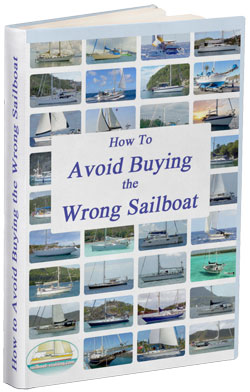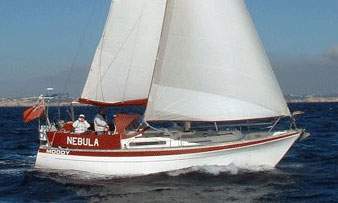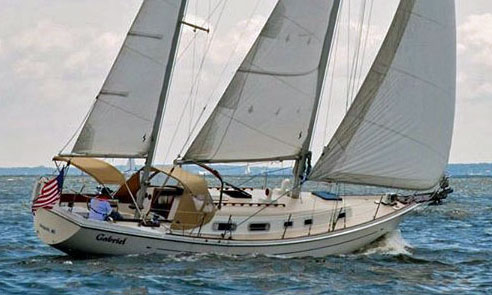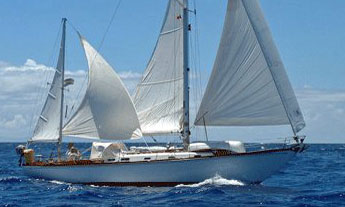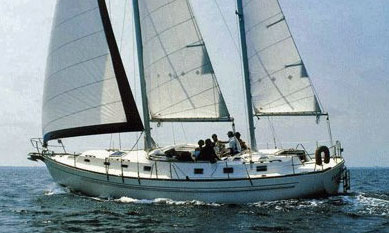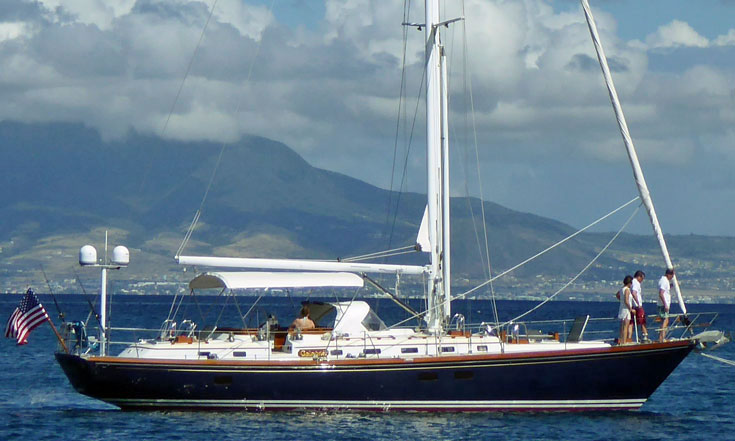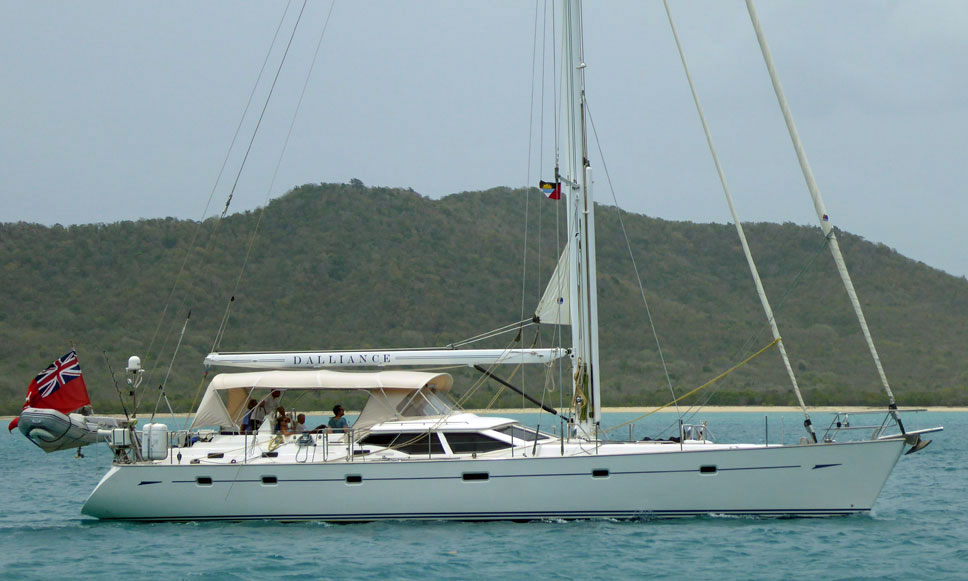- Home
- Cruising Yachts 45' to 50'
- Tayana 48 DS Specs
The Tayana 48 DS
Specs & Key Performance Indicators
The Tayana 48 DS sailboat was designed by Robert Perry and manufactured by Ta Yang Yacht Building Co Ltd. in Taiwan throughout the years 1992 to present.
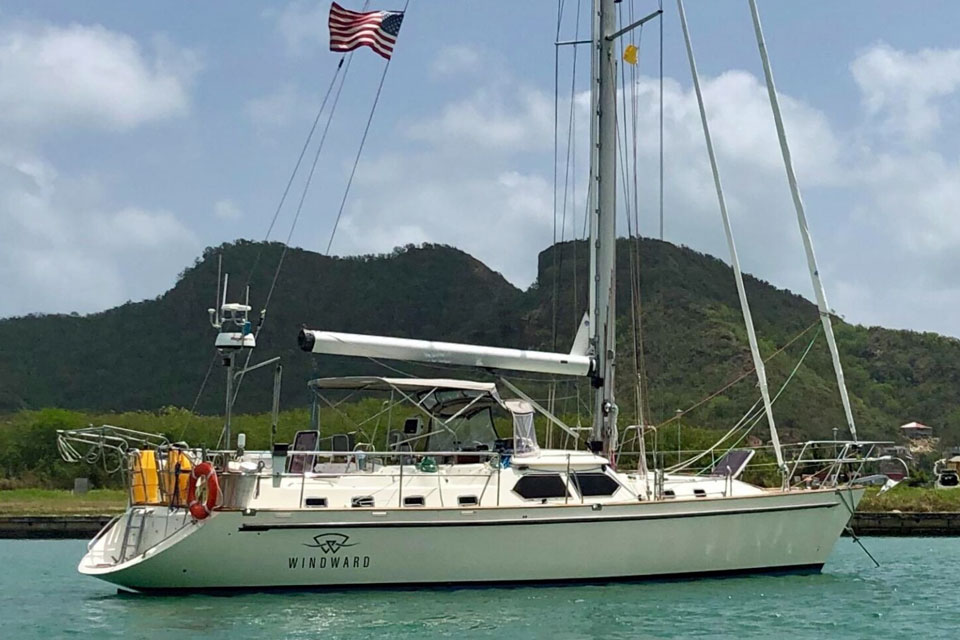 a Tayana 48 DS at anchor
a Tayana 48 DS at anchorPublished Specification for the Tayana 48 DS
Keel & Rudder Configuration: Fin keel with skeg-hung rudder
Hull Material: Fiberglass
Length Overall: 14.63 meters (48'0")*
Waterline Length: 12.19 meters (40'0")*
Beam: 4.42 meters (14'6")*
Draft: 1.83 meters (6'0")*
Rig Type: Cutter rig
Displacement: 15,422kg (34,000lb)*
Ballast: 5,443kg (12,000lb)*
Sail Area: 122.3m2 (1,316ft2)
Water Tank Capacity: 833 litres (220 US gallons)
Fuel Tank Capacity: 454 litres (120 US gallons)
Hull Speed: 15.7 km/h (8.5 knots)
Designer: Robert Perry
Builder: Ta Yang Yacht Building Co., Ltd.
Year First Built: 1992
Year Last Built: Ongoing
Number Built: Over 200 units
* Used to derive the design ratios referred to later in this article - here's how they're calculated...
Options & Alternatives
Alternative versions of the Tayana 48 DS sailboat became available during its production run. The Tayana 47 was an earlier version that was later extended to become the Tayana 48 in 1992.
Additionally, a deck saloon (DS) version was introduced, designed by Rob Ladd, which featured large windows to provide a panoramic view from below. This version helped break up the traditional cabin trunk design and offered a more spacious and well-lit interior.
Published Design Ratios
The Key Performance Indicators (KPIs)
Sail Area/Displacement Ratio (≈19.8): This ratio measures the available sail power relative to the boat's weight. A value of about 19.8 means the Tayana 48 DS has enough sail area to drive the boat efficiently without being overpowered in strong winds. In lighter airs, you can expect the vessel to perform well, yet its moderate sail area also contributes to ease of handling and a less “twitchy” feeling in heavy conditions. Essentially, this ratio suggests a design optimized for balanced performance in a range of wind conditions, making it a true bluewater cruiser.
Ballast/Displacement Ratio (≈33.4%): With roughly one-third of the vessel’s displacement dedicated to ballast, the boat enjoys a good righting moment. This proportion is indicative of a design that can resist excessive heeling and is relatively stable when faced with gusty winds or rough seas. The ratio promotes a steady, comfortable ride, which is particularly important during long ocean passages where comfort and safety go hand in hand.
Displacement/Length Ratio (≈239.6): Falling in the moderate range, this ratio reveals a hull that is neither too heavy nor too light for its overall length. A value around 239.6 indicates that the Tayana 48 DS is built with a solid, load-carrying design—ideal for handling the pounding of waves without sacrificing too much speed. This balance is a hallmark of bluewater cruisers, ensuring that the boat is robust in adverse conditions while still maintaining an adequate pace.
Comfort Ratio (≈36.1): This comfort metric reflects how the vessel is expected to behave in seaway conditions. A comfort ratio of 36.1 suggests that the boat is designed to absorb wave shocks effectively, thereby providing a smoother and more forgiving motion. This is especially valued during long offshore passages where a less “clattery” motion contributes significantly to crew comfort and overall safety.
Capsize Screening Formula (≈1.8): With a value below the safety threshold of 2.0, the capsize screening figure indicates that the Tayana 48 DS has a design inherently resistant to capsize. A result of 1.8 means that even in demanding sea states, the boat's structure is crafted to diminish the risk of overturning—a critical feature for any vessel intended for extended ocean voyages.
But the Design Ratios are Not the Whole Story...
The Design Ratios offer simplified numerical insights into a sailboat’s performance. However, using them to define a sailboat's overall sailing characteristics comes with several notable limitations:
- Simplification of Complex Dynamics: These ratios reduce the interplay of numerous design factors into single numbers. They do not capture the subtleties of hull shape, keel and rudder design, rig efficiency, or the influence of factors like wind gradients and sea state. As a result, they can only provide a general idea rather than a complete picture of dynamic performance.
- Inconsistent Measurement Methods: Often, the data fed into these ratios are based on idealized or manufacturer-specified figures. For example, displacement might be quoted as the “light ship” weight rather than the fully loaded condition, and sail areas may be calculated using different bases (such as a working jib versus a full-coverage genoa). This inconsistency can lead to misleading comparisons between different vessels.
- Static Versus Real-World Conditions: Design ratios are computed from static measurements and assume idealized conditions. They do not account for how a boat’s performance changes when heeled over, nor do they capture the effects of variable wind and wave conditions. Such ratios reflect theoretical potential and therefore might not reliably predict a sailboat’s behavior in actual sailing conditions.
- Emphasis on Limited Aspects: While ratios like sail area/displacement hint at speed potential and displacement/length suggests load-carrying ability, they miss out on other critical factors, such as waterline length variation under load, the impact of crew skill, or the practical nuances of sail trim and rig tuning. This overemphasis on a few numbers can lead to an incomplete assessment of overall performance.
- Lack of Contextual Design Intent: Finally, design ratios do not indicate the intended use of the sailboat. A low displacement/length ratio might suggest an ability to achieve higher speeds, but it doesn’t reveal whether the boat was designed primarily for racing or for comfortable, long-distance cruising. The context of design priorities—whether comfort, safety, or performance—is essential for interpretation but isn’t captured by the ratios alone.
So while design ratios are powerful tools for providing a first-glance estimate of a sailboat’s potential performance, they inherently simplify a complex web of design variables into static, idealized figures. They may be affected by inconsistent measurement standards, lack the nuance of real-world sailing conditions, and often do not reflect the full design intent of the vessel.
Therefore, these ratios should be used alongside detailed design information and practical experience to obtain a complete understanding of a sailboat's sailing characteristics.
More Specs & Key Performance Indicators for Popular Cruising Boats
.........................
I used GPT-4, OpenAI’s large-scale language-generation model, as a research assistant to gather information, summarize research findings, and provide suggestions for the content and structure of this article.
Dick McClary, creator and owner of sailboat-cruising.com
.........................
Recent Articles
-
Sailboat Wheel Steering Maintenance & Inspection Checklist
Dec 30, 25 02:32 PM
Keep your vessel’s helm responsive and reliable with our expert maintenance checklist. Master cable tensioning and system inspections to avoid mid-passage failures. -
Modern Boat Electronics and the Latest Marine Instruments
Dec 20, 25 05:27 PM
Should sailboat instruments be linked to the latest boat electronics as a fully integrated system, or is it best to leave them as independent units? -
Hans Christian 43: Classic Bluewater Cruiser & Liveaboard Sailboat
Dec 10, 25 04:37 AM
Explore the Hans Christian 43: a legendary heavy-displacement, long-keel sailboat. Read our in-depth review of its specs, design ratios, and suitability for offshore cruising and living aboard.
